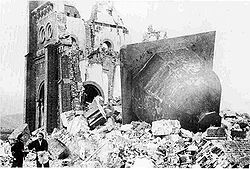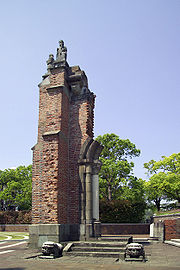
Urakami Cathedral
Encyclopedia
St. Mary's Cathedral, often known as Urakami Cathedral after its location Urakami
, is a Roman Catholic
church located in Motoomachi, Nagasaki, Japan
.
building, began in 1895, after a long-standing ban on Christianity
was lifted.
In 1865, the French priest Bernard Petitjean discovered that almost all the Urakami villagers were Christian. Between 1869 and 1873, over 3600 villagers were banished.
During their exile, 650 died martyrs. The persecuted Kakure Kirishitan
(Hidden Christians) came back to their home village from 7 years exile in 1873, and decided to construct their own church.
They purchased the land of the village chief where the humiliating interrogations had taken place for two centuries. The annual "fumi-e" interrogations required those present to tread upon an icon of the Virgin Mary or Jesus. They thought the place was appropriate considering their memory of the long persecution. Construction of the building was started by Father Francine and was completed under the direction of Father Regani. The frontal twin spires stood 64 meters high were constructed in 1875. When completed in 1925 (Taishō 14), it was the largest Catholic church in East Asia.
The atomic bomb that fell on Nagasaki
on August 9, 1945 detonated in Urakami only 500 m (1640 ft) from the cathedral, completely destroying it. As Assumption of Mary approached, Sacramentum was held on the day. Many Christians congregated in the church. Due to heat rays and collapsed stones all were killed.
A replacement was built in 1959, after a serious debate between Nagasaki city government and the congregation. The city government suggested preserving the destroyed cathedral as a historical heritage, and offered alternate site for a new church.
However, Christians in Nagasaki strongly wanted to rebuild their cathedral on the original place for their historical reasons.
The place is a symbol of the persecution and their suffering. In 1980 it was remodeled to more closely resemble the original French style.
Statues and artifacts damaged in the bombing, including a French Angelus bell, are now displayed on the grounds. The nearby Peace Park
contains remnants of the original cathedral's walls. What remained of the cathedral is now on display in the Nagasaki Atomic Bomb Museum
.


Urakami
Urakami was an area in the northern part of the city of Nagasaki. It is the exact ground zero where the atomic bomb exploded on August 9, 1945. It is the site of Urakami Cathedral, which was the largest cathedral in East Asia before it was destroyed by the bomb and then rebuilt.-External links:...
, is a Roman Catholic
Roman Catholic Church
The Catholic Church, also known as the Roman Catholic Church, is the world's largest Christian church, with over a billion members. Led by the Pope, it defines its mission as spreading the gospel of Jesus Christ, administering the sacraments and exercising charity...
church located in Motoomachi, Nagasaki, Japan
Japan
Japan is an island nation in East Asia. Located in the Pacific Ocean, it lies to the east of the Sea of Japan, China, North Korea, South Korea and Russia, stretching from the Sea of Okhotsk in the north to the East China Sea and Taiwan in the south...
.
History
Construction of the original Urakami Cathedral, a brick RomanesqueRomanesque Revival architecture
Romanesque Revival is a style of building employed beginning in the mid 19th century inspired by the 11th and 12th century Romanesque architecture...
building, began in 1895, after a long-standing ban on Christianity
Christianity in Japan
Christianity is a minority religion in Japan, with less than one percent claiming Christian belief or affiliation. Nearly all known traditional denominations of Christianity, including Roman Catholicism, Protestantism and Orthodox Christianity are represented in Japan today.The root of the Japanese...
was lifted.
In 1865, the French priest Bernard Petitjean discovered that almost all the Urakami villagers were Christian. Between 1869 and 1873, over 3600 villagers were banished.
During their exile, 650 died martyrs. The persecuted Kakure Kirishitan
Kakure Kirishitan
is a modern term for a member of the Japanese Catholic Church that went underground after the Shimabara Rebellion in the 1630s.-History:Kakure Kirishitans are called the "hidden" Christians because they continued to practice Christianity in secret. They worshipped in secret rooms in private homes...
(Hidden Christians) came back to their home village from 7 years exile in 1873, and decided to construct their own church.
They purchased the land of the village chief where the humiliating interrogations had taken place for two centuries. The annual "fumi-e" interrogations required those present to tread upon an icon of the Virgin Mary or Jesus. They thought the place was appropriate considering their memory of the long persecution. Construction of the building was started by Father Francine and was completed under the direction of Father Regani. The frontal twin spires stood 64 meters high were constructed in 1875. When completed in 1925 (Taishō 14), it was the largest Catholic church in East Asia.
The atomic bomb that fell on Nagasaki
Atomic bombings of Hiroshima and Nagasaki
During the final stages of World War II in 1945, the United States conducted two atomic bombings against the cities of Hiroshima and Nagasaki in Japan, the first on August 6, 1945, and the second on August 9, 1945. These two events are the only use of nuclear weapons in war to date.For six months...
on August 9, 1945 detonated in Urakami only 500 m (1640 ft) from the cathedral, completely destroying it. As Assumption of Mary approached, Sacramentum was held on the day. Many Christians congregated in the church. Due to heat rays and collapsed stones all were killed.
A replacement was built in 1959, after a serious debate between Nagasaki city government and the congregation. The city government suggested preserving the destroyed cathedral as a historical heritage, and offered alternate site for a new church.
However, Christians in Nagasaki strongly wanted to rebuild their cathedral on the original place for their historical reasons.
The place is a symbol of the persecution and their suffering. In 1980 it was remodeled to more closely resemble the original French style.
Statues and artifacts damaged in the bombing, including a French Angelus bell, are now displayed on the grounds. The nearby Peace Park
Nagasaki Peace Park
Nagasaki Peace Park is a park located in Nagasaki, Japan, commemorating the atomic bombing of the city on August 9, 1945 during World War II.-History:...
contains remnants of the original cathedral's walls. What remained of the cathedral is now on display in the Nagasaki Atomic Bomb Museum
Nagasaki Atomic Bomb Museum
The is in the city of Nagasaki, Japan. The museum remembers the explosion of the atomic bomb that devastated Nagasaki at 11:02:35am on 9 August 1945.The first atomic bomb museum was built in 1945...
.


See also
- The Bells of NagasakiThe Bells of Nagasakiis a 1949 book by Takashi Nagai. It vividly describes his experiences as a survivor of the Atomic bombing of Nagasaki. It was translated into English by William Johnston. The title refers to the bells of Urakami Cathedral, of which Nagai writes:...
a book written by Takashi NagaiTakashi Nagaiwas a physician specializing in radiology, a convert to Roman Catholicism, and a survivor of the atomic bombing of Nagasaki. His subsequent life of prayer and service earned him the affectionate title "saint of Urakami".-Life:...
, about the bell of the Cathedral

